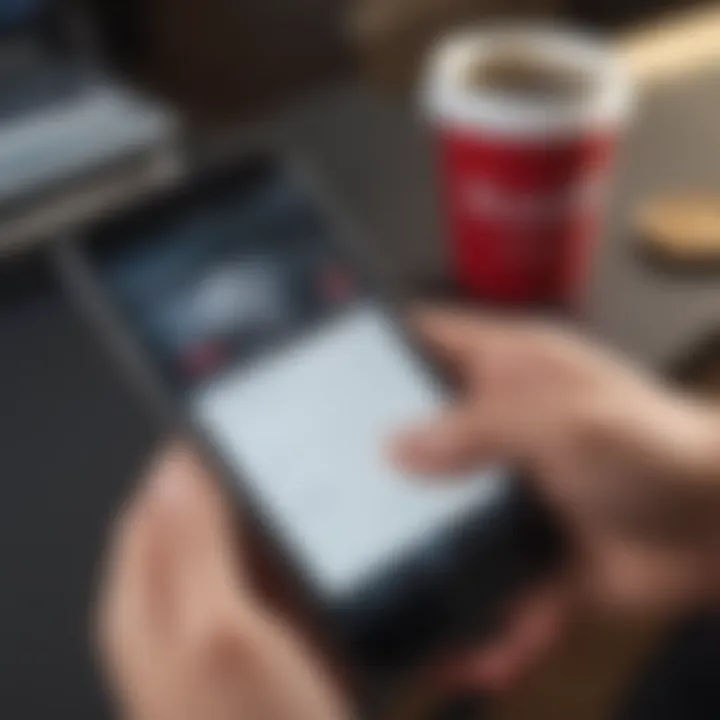Comprehensive Review of Bank of America Mobile Banking


Overview of the Topic
Mobile banking has revolutionized the way we handle finance in today’s digitally-driven world. Bank of America’s mobile banking service exemplifies this shift, providing customers with convenient access to their financial accounts right at their fingertips. The definition of mobile banking is relatively straightforward—it involves managing banking transactions through smartphones or tablets. However, its significance is anything but simple. In an era where speed and ease of use matter immensely, mobile banking allows users to conduct transactions, monitor their spending, and even manage investments without stepping into a physical bank.
The advantages of using Bank of America’s mobile banking platform are multifaceted. Users can check their balance, transfer funds, pay bills, and deposit checks using their phones. Efficiency is a game changer for many individuals juggling various responsibilities. In addition, mobile banking provides real-time updates, enhancing personal finance awareness and management.
Importantly, the implications of this technology stretch beyond convenience. It fosters financial literacy by making information accessible, it enhances security through multi-factor authentication, and it encourages savings habits by allowing seamless tracking of expenses. People are increasingly realizing that mobile banking tools are central to modern financial management.
Exploring Strategies and Tips
Navigating the world of mobile banking can be daunting for some. To harness the potential of Bank of America’s mobile app, users should keep a few strategies in mind.
- Regularly monitor your account: Engaging with your finances daily or weekly helps keep spending in check. Regular monitoring also allows users to spot any discrepancies before they escalate.
- Utilize budgeting features: Bank of America provides tools to help users visualize their spending habits. Users should take advantage of these features to make informed choices about their finances.
- Enable alerts: Setting up notifications for transactions or low balances ensures users remain aware and can act promptly if something seems off.
Implementing these strategies effectively can simplify personal finance management. It’s like keeping your house in order—if you tidy up frequently, messes don’t become overwhelming.
Case Studies and Examples
Real-life experiences often shed light on the potential pitfalls of mobile banking. One noteworthy example is a customer who relied heavily on the app without setting up alerts for unusual transactions. They later encountered unauthorized transactions that proved stressful to resolve. This case highlights the importance of vigilance and proactive account management.
Conversely, many users have successfully integrated mobile banking into their routines. An individual who used Bank of America’s budgeting tools saw a significant reduction in their monthly spending over time. By understanding their financial habits more clearly, they could make smarter financial decisions, leading to increased savings.
Comparison of Financial Products
When evaluating Bank of America’s mobile banking services, it’s also useful to look at them in contrast with what competitors offer. Products like Chase, Wells Fargo, and Citibank offer similar services but may differ in terms of user interface, features, or fees associated with transactions and accounts.
- Chase: Known for a user-friendly app that includes personal finance tools. However, certain features tend to have fees.
- Wells Fargo: Offers the ability to send money through Zelle, but has faced criticism for their banking practices.
- Citibank: Provides excellent integration with investment accounts but may not be as intuitive for everyday banking needs.
Each of these platforms presents its pros and cons, and understanding them thoroughly helps users make decisions tailored to their individual financial needs.
Expert Insights and Recommendations
As stated by financial analysts, the rise of mobile banking is unlikely to slow down. Bank of America stands out because of its robust features and emphasis on security. Financial professionals encourage all users to familiarize themselves with the app’s myriad features and use them to their advantage.
Recommendations include:
- Leveraging financial tools offered in the app to plan for future expenses.
- Completing any necessary training or tutorials provided within the app to maximize its potential.
- Staying up to date on any new features or updates from Bank of America to know what's available.
"In today's fast-paced world, being savvy with mobile banking is not just advantageous—it's essential for securing your financial well-being," says a finance educator.
Embracing these tools can help manage personal finance efficiently, positioning users for a stronger financial future.
Prologue to Mobile Banking
The rise of mobile banking isn't just a fad; it's a monumental shift in the financial landscape. Technology has reshaped how consumers interact with their banks and manage their money. As we delve into the world of mobile banking, it's vital to understand its significance, particularly as it relates to Bank of America. This institution stands at the forefront of digital financial services, leading innovations that cater to a generation that craves convenience and accessibility.
When contemplating mobile banking, several crucial elements come to mind. First, the sheer convenience it offers cannot be overstated. Consumers can transfer funds, pay bills, and check account balances without stepping foot inside a bank. Imagine standing in a long line at the bank while you could easily handle those transactions with a few taps on your smartphone. This ability to manage personal finances on-the-go fundamentally alters the relationship individuals have with their money.
However, it’s not all glitz and glamour. Users also need to be aware of considerations such as security, usability, and customer support. For many, the thought of banking via a handheld device raises questions: Is my information safe? Will I receive adequate assistance if needed? Addressing these considerations is essential for fostering trust among customers.
"Mobile banking is not just about technology; it's about empowering individuals to take control of their financial lives."
Overview of Mobile Banking
Mobile banking typically refers to the use of mobile devices to conduct banking transactions and manage personal finances. This includes a range of activities such as checking account balances, depositing checks, and transferring money between accounts. With the advent of smartphones, these activities have become more accessible than ever.
In recent years, mobile banking has evolved beyond mere transactions. Many banks now offer services such as comprehensive budgeting tools and investment options, allowing users to manage their entire financial portfolios in one place. It seems the future is bright for those who can embrace and adapt to these rapid changes.
The Evolution of Banking Technology
The evolution of banking technology is a captivating narrative. In the past, banking was confined to brick-and-mortar establishments. People would wait in lines, fill out paperwork, and often encounter the frustrations of traditional banking hours. Fast forward to the late 20th century, where the introduction of online banking started to carve a new path for financial interactions.
As technology improved, so did the capabilities of banking solutions. The introduction of mobile banking apps marked a turning point. Banks diversified their services, integrating features that catered to customer needs. Today’s platforms are designed with user experience in mind, encouraging engagement by making complex financial processes simple and intuitive.
- Key Milestones in Banking Technology Evolution:
- ATM Introduction (1960s): Allowed cash access without human interaction.
- Online Banking (1990s): Brought banking to computers at home.
- Mobile Banking Apps (2000s-Present): Empowering users to manage finances anytime, anywhere.


Looking ahead, it stands clear that the pace of change in the banking industry is not going to slow down. Innovations are likely to keep rolling out, continually shaping how individuals and businesses interact with financial services.
Bank of America: A Leader in Mobile Banking
Bank of America has carved a prominent niche in the landscape of mobile banking. Its significance in this arena cannot be overstated. As a major player in the financial sector, Bank of America has consistently prioritized innovation and customer satisfaction, making it a standout option for mobile banking users. With millions of account holders relying on it for everyday transactions, the bank's mobile banking platform is not merely an extension of traditional banking—it has transformed how people interact with their finances.
The bank's commitment to providing a seamless banking experience is evident in its evolving services, which include a broad range of functionalities. Users can manage their accounts, transfer funds, and pay bills all from their smartphones. This convenience is particularly critical in today's fast-paced life, where taking time out to visit a physical bank branch is not always feasible.
Moreover, Bank of America has taken steps to ensure that its mobile platform aligns with user needs and preferences. The aim has been clear: to empower users with control and access to their financial data. As a result, features designed to enhance user experience—like customized alerts and budgeting tools—have become essential components of their app, reinforcing Bank of America's leadership position in mobile banking.
Historical Background of Bank of America
The history of Bank of America provides a rich context for understanding its place in mobile banking today. Founded in 1904 as the Bank of Italy in San Francisco, the institution aimed to meet the needs of immigrants who had been overlooked by traditional banks. Over the decades, it underwent several transformations, both in operation and scope, eventually becoming Bank of America in 1930.
Throughout the 20th century, the bank expanded significantly, acquiring numerous smaller institutions and establishing a nationwide presence. It adapted to technological advancements, embracing innovations like ATMs in the 1970s and online banking in the 1990s. This history of adaptation has laid the groundwork for its current mobile banking services. As smart devices exploded in popularity, so too did Bank of America's investment in mobile technology, making it one of the first major banks to launch a dedicated mobile banking app.
Growth of Mobile Banking Services
The rise of mobile banking services at Bank of America can be encapsulated through its proactive approach to customer needs and technology integration. With consumer behaviors shifting towards mobile-centric interactions, the bank capitalized on this trend by enhancing and expanding its mobile offerings. In the early days of the smartphone boom, Bank of America recognized the opportunity to make banking as accessible as possible. This foresight has paid off; the bank has reported significant increases in mobile banking users over the years.
Key features of its mobile banking platform, such as mobile check deposit and digital wallets, were crucial in attracting users who wished for convenience. Not only did this enhance user experience, but it also positioned Bank of America as a trendsetter in mobile banking—serving as a benchmark for competitors. Furthermore, the bank's ongoing commitment to user feedback has cultivated a platform that evolves alongside customer preferences—integrating new functionalities to ensure satisfaction and retention.
In summary, Bank of America's historical background and growth in mobile banking services illustrate a proactive response to market demands. The trajectory the bank has taken serves as a roadmap on how to stay ahead in an ever-evolving financial landscape.
Features of Bank of America Mobile Banking
When it comes to mobile banking, it's crucial to recognize what features set an institution apart from the rest. Bank of America offers a comprehensive suite of tools designed to cater to the evolving needs of its users. With the increase in mobile banking adoption, understanding these features not only enhances user experience but also plays a significant role in personal finance management. This section delves into three key aspects of Bank of America's mobile banking—Account Management Capabilities, Transfer and Payment Options, and Bill Payment Features.
Account Management Capabilities
The ability to manage accounts from your mobile device has become a linchpin of modern banking. Bank of America’s mobile app allows users to view account balances, transaction histories, and even set up alerts for low balances or significant transactions. Users can securely log in using biometric data, which streamlines access and adds an extra layer of security.
- Account Overview: Users can see all their accounts in one place—checking, savings, or investment—and monitor activity in real-time. This is particularly useful for tracking spending habits and ensuring financial goals are met.
- Fund Transfers: The app supports seamless internal transfers and external wire transfers, enabling users to move funds quickly without needing to visit a physical branch.
- Virtual Card Numbers: For enhanced security during online shopping, users have the option to generate a virtual card number—keeping their real card number hidden from potential threats.
The ability to manage these aspects via a mobile platform fosters a sense of control and awareness over finances, making it easier for users to make informed decisions.
Transfer and Payment Options
Time is money; this saying rings true when it comes to making payments and transfering funds. Bank of America offers a user-friendly interface that simplifies these processes. Whether it's paying a friend or settling a bill, users have various options at their fingertips.
- P2P Payments: The app integrates with services like Zelle, which allows users to send or receive funds from friends instantly, making it perfect for shared expenses.
- Scheduled Transfers: Users can set up recurring payments or fund transfers, which is particularly helpful for managing regular expenses such as rent or subscriptions.
- International Transfers: For those needing to send money overseas, Bank of America supports international wire transfers, all managed through the app, maximizing convenience.
This array of transfer options ensures that users can handle their financial duties without the hassle typically associated with transaction processes.
Bill Payment Features
Bill payments can sometimes feel like a chore, but Bank of America aims to make this as efficient as possible, allowing users to set reminders and schedule payments ahead of time.
- Direct Bill Pay: Users can pay their utility bills or credit card payments directly from the app, which reduces the need for multiple platforms.
- Payment History Tracking: The ability to track what bills have been paid and when is invaluable for budgeting purposes; it enhances transparency over finances.
- E-Bills: By enabling e-bills, users can receive and pay bills electronically, which not only saves paper but also streamlines the payment process.
"Having all payment options in one convenient app not only saves time but also gives peace of mind in knowing that everything is managed efficiently."
In summary, the features of Bank of America’s mobile banking are pivotal in providing a user-friendly experience that aligns with the demands of today’s fast-paced financial landscape. With effective account management, robust transfer options, and simplified bill payments, users are equipped to handle their finances more effectively.
User Experience and Interface Design
The significance of user experience in mobile banking cannot be overstated. A well-designed interface serves as the backbone of any successful mobile application, especially in banking where users engage with their financial information regularly. Practically speaking, it’s about creating a seamless path for users to navigate their accounts, pay bills, and perform transactions without frustration. In a fast-paced world, getting things done efficiently can make all the difference between a satisfied customer and a lost opportunity.
Navigating the App: A User Perspective
When individuals download the Bank of America mobile app, the first encounter is the user interface, which ideally should possess a simple yet effective design. Users typically expect their banking app to hold their hand through various tasks. This includes everything from checking balances to transferring money between accounts. The layout is often crucial; if users can't easily find what they need, they’re likely to get annoyed and abandon their goals.
Bank of America’s app is designed to be intuitive. A clean, organized Dashboard greets users, displaying account balances front-and-center. Account activity is just a tap away, providing quick insights. Notably, users should appreciate features like customizable widgets, which allow for a personalized touch.
Customizing User Settings
Customization features enable users to tailor the app experience to their unique needs. Upon logging in, customers can access settings where they can adjust notification preferences, security settings, and even color themes to reflect personal style. These elements play not only into user satisfaction but also security; for instance, opting for real-time transaction alerts provides an added layer of awareness about one's finances.
Key Customization Options:


- Notification Preferences
Users can opt for alerts about account transactions, bill payments, and suspicious activities. This ensures you are always in-the-know about your financial movements. - Biometric Log-in
Adding a fingerprint or facial recognition speeds up the log-in process while boosting security. This is a notable trend, as many users prefer minimal friction yet robust protection. - Personalized Dashboard
The option for a customized home screen allows users to arrange their most-used features for quicker access.
Security Features and Concerns
In an age where digital transactions have become part and parcel of daily life, security in mobile banking isn't just important; it’s crucial. Security features don't merely protect accounts; they bolster user confidence in managing finances through their mobile devices. Bank of America, recognizing this, has developed robust security measures. These mechanisms not only safeguard sensitive information but also facilitate a seamless banking experience. Whether you're transferring funds or checking your account balance on the go, understanding these security elements can lead to safer banking practices.
Authentication and Protection Mechanisms
Two-Factor Authentication
At the heart of Bank of America's security is Two-Factor Authentication (2FA). This is like having two locks on your front door: a simple username and password is the first lock, but 2FA adds another layer. Basically, after typing in your credentials, a code is sent to your phone. This key element means someone who might have your password still can’t just waltz in without that code.
Why is it beneficial? Well, it significantly reduces the risk of unauthorized access. Hackers often employ various techniques, like phishing to gain passwords, but if you have 2FA enabled, it’s like trying to break into a vault that requires a key plus a fingerprint.
A unique feature of 2FA is its versatility; it can be done via text, voice call, or authentication apps. However, users should be aware that relying solely on SMS for codes can have its drawbacks. Signal issues or a stolen phone can complicate things, so diversifying the method can be a smart move.
Biometric Security
Biometric security takes it a step further. This is about using physical traits—for instance, fingerprints or facial recognition—to verify identity. Bank of America's mobile app allows users to log in using their unique biological markers, making it a convenient and efficient choice.
The standout characteristic of biometric security is its one-of-a-kind markers. Your face or finger is not just any code; it’s uniquely yours. This level of personalization makes it a strong choice for security. However, it is not without potential downsides. There are concerns regarding how securely this data is stored and the possibility of false rejections, where legitimate users are denied access.
Addressing Common Security Risks
Even with high-level security measures, risks remain. The danger of unintentional breaches is ever-present. Some common risks include phishing scams, app vulnerabilities, and unsecured public Wi-Fi networks. Users should remain vigilant and educated about these threats.
- Phishing Scams: Always be cautious about unsolicited requests for personal info, especially those that sound too good to be true.
- App Vulnerabilities: Keep the app updated to benefit from recent security patches.
- Unsecured Networks: Avoid accessing sensitive accounts over public Wi-Fi. It's like trying to read a book in a crowded café—sure, you can try, but it’s not the safest spot for privacy.
The Role of Mobile Banking in Personal Finance
Mobile banking plays a pivotal role in shaping how individuals manage their finances today. The integration of banking services into mobile devices has transformed traditional banking convenience into a dynamic tool for personal finance management. With its ability to provide real-time access to accounts, facilitate transactions, and deliver tailored financial advice, mobile banking has become an essential part of everyday financial activities.
The increasing reliance on mobile banking reflects a broader shift towards more immediate, accessible, and streamlined banking services. Users can now conduct a variety of banking tasks directly from their smartphones, whether they are at home or on the go. This capability not only enhances user engagement but also supports better financial decision-making by providing the necessary tools right at one’s fingertips.
"The growing use of mobile banking indicates a significant evolution in how consumers engage with their financial institutions."
Budgeting and Expense Tracking
Budgeting is a fundamental aspect of personal finance, and mobile banking apps offer innovative features to make this task less daunting. These apps often include built-in budgeting tools that allow users to set financial goals, categorize expenses, and track spending in real-time.
For instance, a user might set a monthly budget for groceries and receive alerts when they are nearing that limit. This real-time feedback not only aids in adhering to budgets but encourages users to reassess their spending habits. Beyond just numbers, seeing a visual representation of expenses helps to enhance awareness and discipline around spending.
Furthermore, tracking expenses becomes much simpler with mobile apps. Users can categorize transactions automatically, view spending patterns, and analyze their habits over time. For example, Bank of America’s app allows users to utilize features like
- Expense categorization
- Visualization of spending trends
- Reports that summarize monthly financial activities
These tools encourage proactive engagement with one's budget, making financial management less intimidating and more straightforward.
Investment Management Integration
Investment management is increasingly tied to personal finance strategies, and mobile banking makes integration easier than ever. Many mobile banking applications now offer direct access to investment accounts, enabling users to monitor their portfolios alongside their everyday banking activities. This seamless integration promotes a holistic view of one’s financial health.
Users can set investment goals, adjust portfolios, and explore market trends without needing to log into multiple platforms. For instance, through Bank of America, users may take advantage of features such as
- Real-time stock price updates
- Portfolio performance tracking
- Educational resources for aspiring investors
Additionally, the convenience of mobile banking promotes informed investment decisions. Users can receive timely notifications about market movements, allowing them to act quickly when opportunities arise. This immediacy helps in adapting strategies according to market conditions, fostering a proactive investing approach that can lead to better stock selection and timing.
As mobile banking continues to evolve, the integration of personal finance management and investment tools seems poised to grow, contributing significantly to users' overall financial literacy and capability. Engaging with financial opportunities through a single interface paves the way for more sophisticated financial planning and wealth management strategies.
Comparative Analysis with Other Banking Apps
When discussing mobile banking, it's essential to engage in a comparative analysis with other banking apps on the market. This approach allows for a nuanced understanding of where Bank of America stands in relation to its competitors. Analyzing these aspects sheds light on the performance, features, and customer satisfaction metrics across different platforms.
Market Positioning of Bank of America
Bank of America consistently finds itself amidst the heavyweights in the mobile banking arena. It possesses a substantial market share, largely due to its long-standing reputation and expansive branch network. Users often gravitate towards it not only for its robust banking solutions but also for its significant technological investments. The seamless interface and reliable customer service further bolster its status.
The strategy behind Bank of America's market positioning has been to blend tradition with innovation. Users have exhibited a tendency to prioritize reliability in their banking experiences. As Bank of America pivoted towards digital enhancements, it managed to attract a younger demographic while still catering to its established clientele. The result? A balanced portfolio that maximizes its appeal across various age groups. This positioning might just be what it needs to fend off new challengers entering the mobile banking space.
Feature Comparisons with Competitors


To truly appreciate Bank of America's mobile banking capabilities, it's crucial to compare its features with those offered by other leading banking apps such as Chase, Wells Fargo, and Citibank. Here are some of the key dimensions to consider:
- User Interface and Experience: Many users commend Bank of America's app for its intuitive design. Folks find it easy to navigate and locate features like fund transfers and account statements. Despite this, some competitors, like Chase, have invested in gamified elements that engage users differently, keeping them fel engaged and encouraged to utilize more of the app's robust options.
- Transaction Capabilities: Bank of America allows for a diverse array of transactions including peer-to-peer payments. However, when viewed against competitors such as Venmo or Cash App, which specialize in peer-to-peer transactions, it can appear somewhat basic.
- Budgeting Tools and Resources: The budgeting tools featured in Bank of America's app are solid, but competitors like Personal Capital or Mint offer in-depth analytics that provide insights into spending habits. This advanced financial guidance can help users plan their finances more effectively.
- Rewards and Incentives: In terms of rewards, differences can be stark. Bank of America offers cashback and incentives linked to credit card usage, but some apps, like Discover, offer higher rewards rates, which can influence user preferences.
Comparing features reveals much about what is it like to use Bank of America's mobile banking services. Users often analyze everything from fees to functionality, which informs their decisions and ultimately dictates their satisfaction levels. By understanding these comparisons, one can better grasp why users either stick around or jump ship.
"In the world of mobile banking, comparing features and positioning can spell the difference between loyalty and apathy."
Thus, as the digital banking landscape continues to evolve, Bank of America's ability to maintain and enhance its offerings during such comparative analyses emerges as a cornerstone of its continued success.
User Feedback and Reviews
Understanding user feedback and reviews is crucial in evaluating Bank of America's mobile banking services. In the competitive world of banking apps, users' opinions provide insights into the strengths and weaknesses of the platform. This section aims to delve into the positive aspects highlighted by users as well as the common complaints and issues they face.
Positive Aspects Highlighted by Users
Many users have expressed their satisfaction with Bank of America’s mobile app for several reasons:
- User-Friendly Interface: Often mentioned is the app's simple layout, making it easy for both tech-savvy and less experienced users to navigate. They appreciate how it presents complex banking functions in a comprehensible manner.
- Robust Features: Users frequently laud the variety of features available. They can perform tasks like checking balances, making transfers, and even investing right from the app. Such versatility removes the need for separate financial tools.
- Customer Service Accessibility: Positive reviews often note the ease of reaching customer support through the app. Live chat options and responsive service make a significant difference for users when issues arise.
- Security Measures: Although security is always a concern, many users feel reassured by the implementation of advanced security features like two-factor authentication, keeping their financial data more secure.
"Using Bank of America’s app really simplifies everything. It feels safe and meets my banking needs without hassle."
Common Complaints and Issues
Despite the numerous positive aspects, there are several common complaints that users have raised concerning the app:
- App Glitches: Some users report experiencing bugs that sometimes interfere with their ability to complete transactions or log in to the app. These glitches can be frustrating and detrimental to quick banking needs.
- Limitations on Transfers: Various users voice their displeasure with limitations imposed on transfer amounts and frequency. This can be constraining for those who rely on mobile banking for their financial transactions.
- Lack of Features Compared to Competitors: Some users feel that while the app has many features, it still lacks certain functionalities that other banking apps offer, like personalized financial advice or spending analysis tools.
- Frequent Updates: While updates can improve an app, continual changes can lead to confusion among users who have become accustomed to a particular layout or feature set.
To conclude, user feedback and reviews reflect a mixed bag of experiences with Bank of America's mobile banking app. Enhanced features and usability are often balanced against some disappointing glitches and limitations. This feedback is invaluable in shaping the future updates and services provided by the bank.
Future of Mobile Banking: Trends and Innovations
As we peer into the crystal ball of mobile banking, it becomes crystal clear that this sector is undergoing a tectonic shift. The advent of new technologies is not just a buzzword; it fundamentally alters how users interact with their finances. Understandably, this is particularly vital in this discussion as it highlights the ways in which Banking of America adapts to changing consumer behaviors and expectations. Embracing these trends offers a roadmap for understanding user needs and enhancing their financial journeys.
Emerging Technologies to Watch
Artificial Intelligence Applications
Artificial intelligence (AI) is poised to become a cornerstone of mobile banking. It steps beyond mere automation; AI elevates customer service through chatbots that provide 24/7 support, predictive analytics that customize user experiences, and advanced fraud detection systems that safeguard assets. One of the key characteristics of AI applications is their ability to learn from user interactions. This means less guesswork and more tailored services based on a user’s individual habits and preferences.
The unique feature of these applications lies in their ability to analyze vast amounts of data in real-time. For instance, Bank of America leverages predictive models to anticipate a user’s needs before they even realize them. While the benefits are considerable, it's worth noting that integrating AI comes with challenges, such as addressing privacy concerns and ensuring the systems are free from bias. However, when implemented thoughtfully, AI can certainly redefine user engagement in the mobile banking arena.
Blockchain Integration
Blockchain technology is another game-changer transforming the landscape of mobile banking. It introduces a level of transparency and security that peers into the future of transactions. The immutable nature of blockchain not only fosters trust among users but also facilitates quicker settlements with reduced costs. One significant characteristic is its decentralized system, which can minimize reliance on traditional banking infrastructures.
For Bank of America, utilizing blockchain could streamline processes like cross-border payments. Moreover, this unique feature potentially reduces fraud risks and enhances traceability in financial transactions, signaling a leap forward in security measures. Nevertheless, the technology has drawbacks, including scalability issues and regulatory uncertainties, which could impede its immediate adoption. Despite these challenges, blockchain represents a future brimming with potential in the realm of mobile banking.
Anticipating Changes in User Behavior
As these technologies evolve, so too does user behavior. With the integration of AI and blockchain, one can anticipate a shift toward a more personalized banking experience. Users are likely to begin demanding more from their banks, pushing for intuitive self-service options, while also being more vigilant about data privacy and security. This ongoing evolution necessitates that Banking of America and others remain vigilant and proactive in understanding consumer mindsets.
The coming years will see a more pronounced expectation for seamless digital experiences, making it essential for banks to prioritize not only technology but also the human element comprising transparency, responsiveness, and trustworthiness. Banking institutions that can read the tea leaves of consumer behavior will certainly prosper in the competitive landscape of mobile banking.
"The future of mobile banking thrives on the blend of cutting-edge technology and an unwavering focus on user experience, remaining ever vigilant to the changing tides of consumer demand."
The trends and innovations in mobile banking present a dual-edged sword: while they usher in a new era of convenience and security, they also challenge banks to rethink user interactions and address emerging concerns. The journey ahead is undoubtedly intriguing and requires careful navigation.
Culmination
In the realm of personal finance, mobile banking represents a significant shift in how individuals manage their money. This article delved into the various facets of Bank of America’s mobile banking services, illustrating its evolution, unique features, and user experience. With technology weaving itself into the fabric of everyday transactions, understanding the role of such platforms has never been more vital.
Recap of Key Takeaways
The exploration of Bank of America's mobile banking capabilities brought to light several important points:
- User Accessibility: The convenience of banking from anywhere is a game changer. Customers can manage accounts seamlessly via their smartphones.
- Robust Security Measures: Attention to security, including two-factor authentication and biometric security features, ensures users feel safe while conducting transactions.
- Comprehensive Tools for Financial Management: Integrated apps help users track spending, create budgets, and even monitor investments, making financial planning more tangible.
- Continuous Innovation: As technology advances, so too does the functionality of mobile banking, highlighting the necessity for users to stay abreast of emerging trends.
Final Thoughts on Mobile Banking Evolution
The future trajectory of mobile banking is poised for remarkable changes. As different technologies like artificial intelligence and blockchain gain traction, we can expect the landscape of personal finance to shift dramatically. Ultimately, Bank of America is reflecting these changes, ensuring that its mobile banking app not only meets contemporary demands but anticipates what users will require moving forward. Keeping a finger on the pulse of this evolution, coupled with an understanding of one’s own financial habits, can lead to more informed financial decisions. In a world where time is money, efficient and secure banking solutions are paramount for empowering users.
"The evolution of mobile banking is not merely a trend; it is a transformative force shaping modern finance."
To summarize, the importance of examining Bank of America’s mobile banking services extends beyond its current offerings; it anchors itself in the broader understanding of how technology impacts personal finance management today and into the future. By embracing these tools, individuals can optimize their financing strategies, enhance their investment efforts, and navigate the intricacies of modern financial landscapes.



